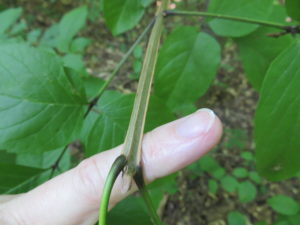By Bill McNee, forest health specialist, Oshkosh, Bill.Mcnee@wisconsin.gov, 920-360-0942
Many people interested in trees know about Wisconsin’s white, green and black ash species. However, there’s a fourth species that fewer people know about. Blue ash, Fraxinus quadrangulata, occurs naturally only at a few sites in Waukesha County. It can easily be identified by the cork ridges on the twigs, which give them a four-sided, square appearance. The tree was given its name because of the blue dye that is produced by soaking the inner bark in water.

Four-sided, square twig of a blue ash. Photo by Bill McNee.
Blue ash is listed as a “threatened” species due to its limited distribution in Wisconsin, but it is much more abundant in several states south of Wisconsin. It is a medium-sized tree that typically grows on rich, upland sites where calcium-containing limestone or dolomite is close to the surface. It is occasionally planted as an ornamental.
Blue ash is Wisconsin’s rarest native ash species, and it’s also the most tolerant of being infested by emerald ash borer (EAB). Studies in other states have found that a majority of larger blue ash survive EAB infestations compared to white, green and black ash of similar size. For these more common ash species, up to 99% tree mortality from EAB has been observed in long-infested areas.
#NASF100
